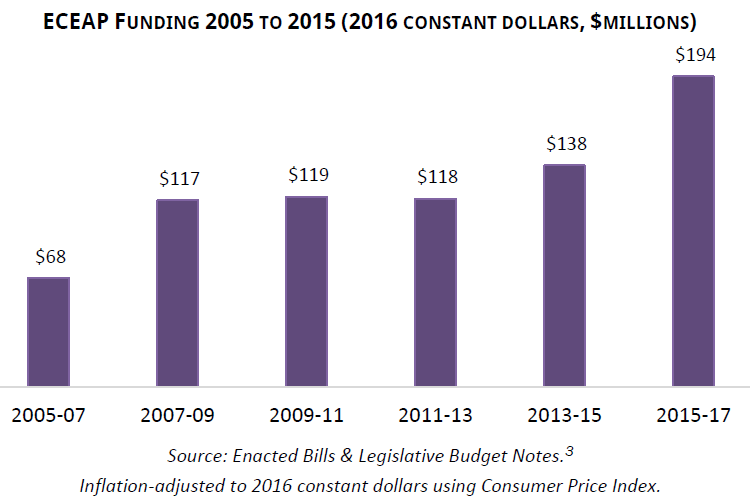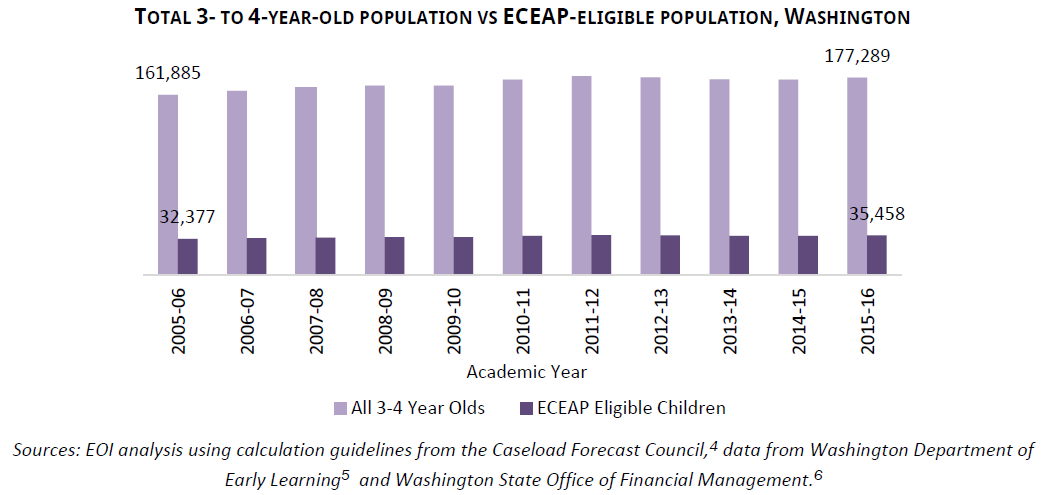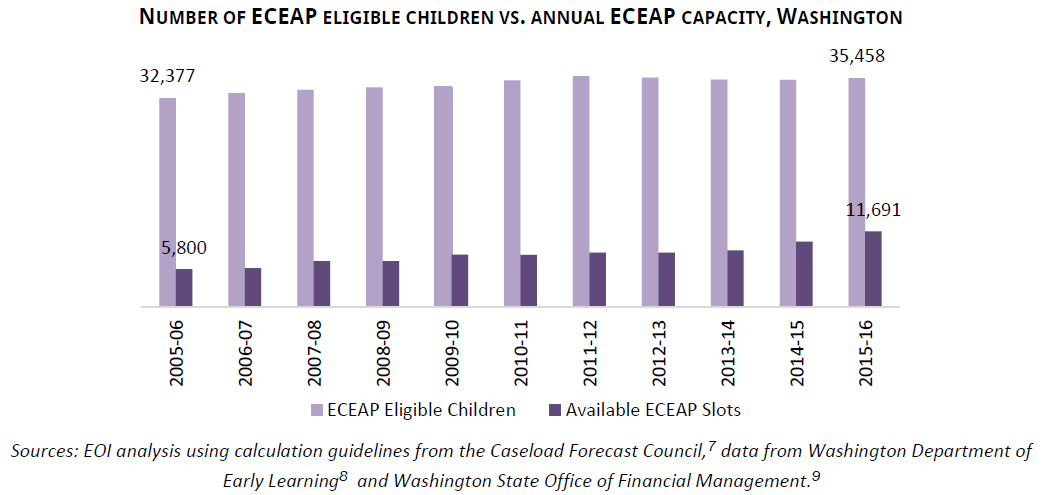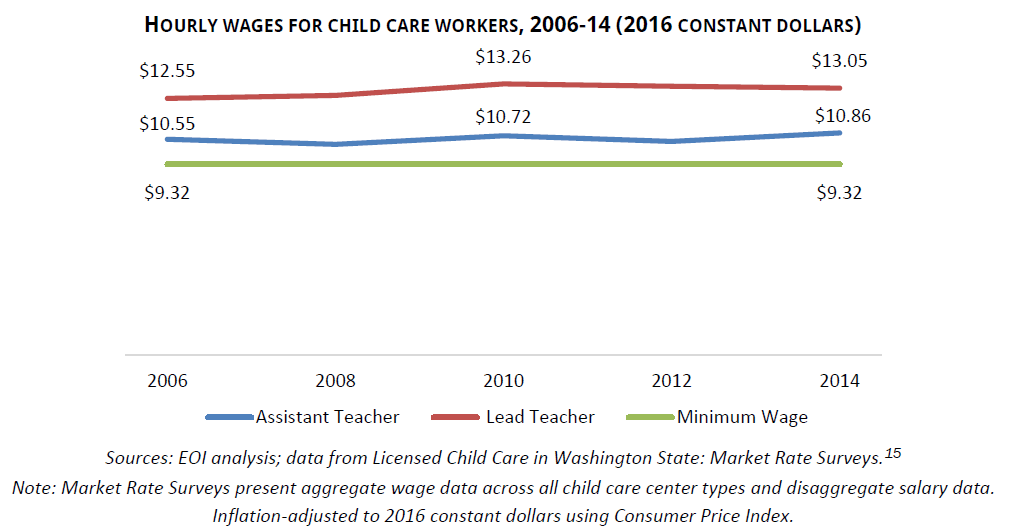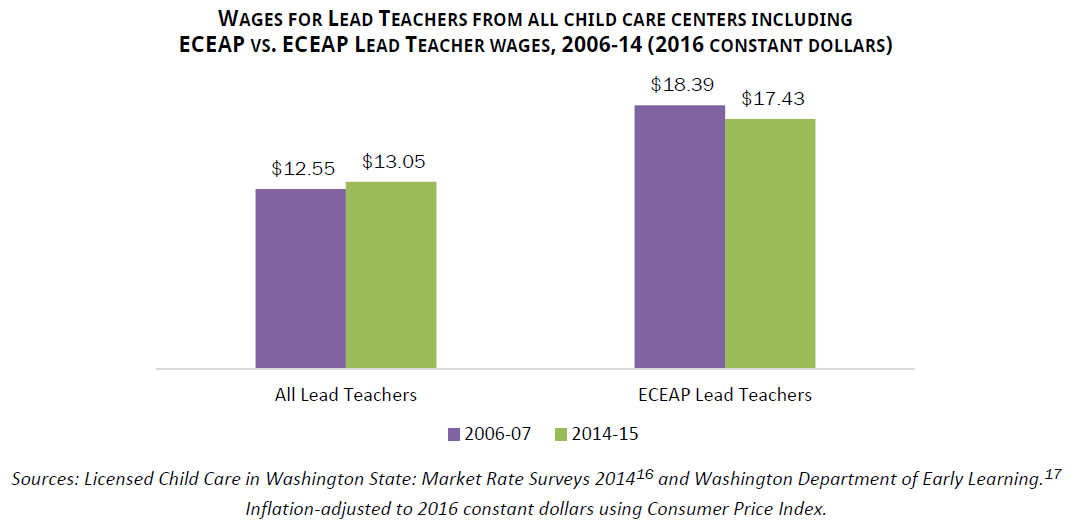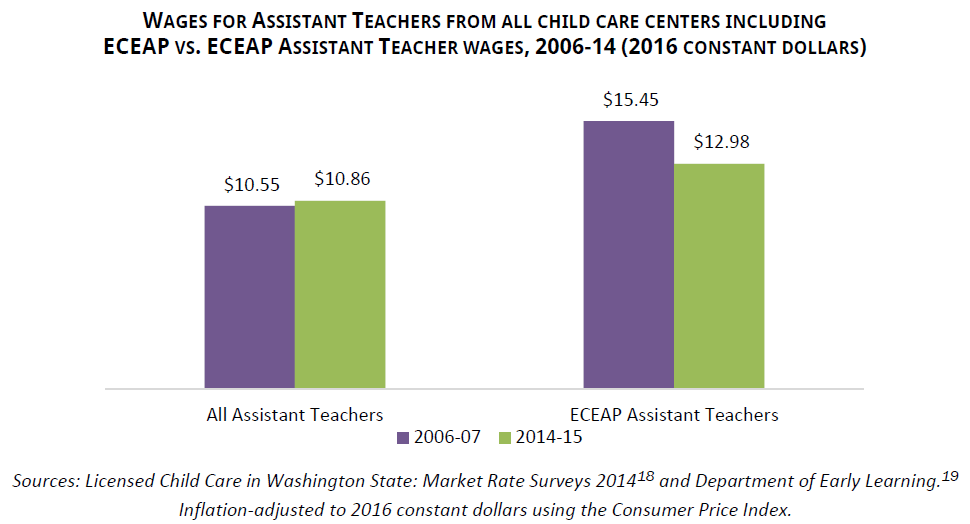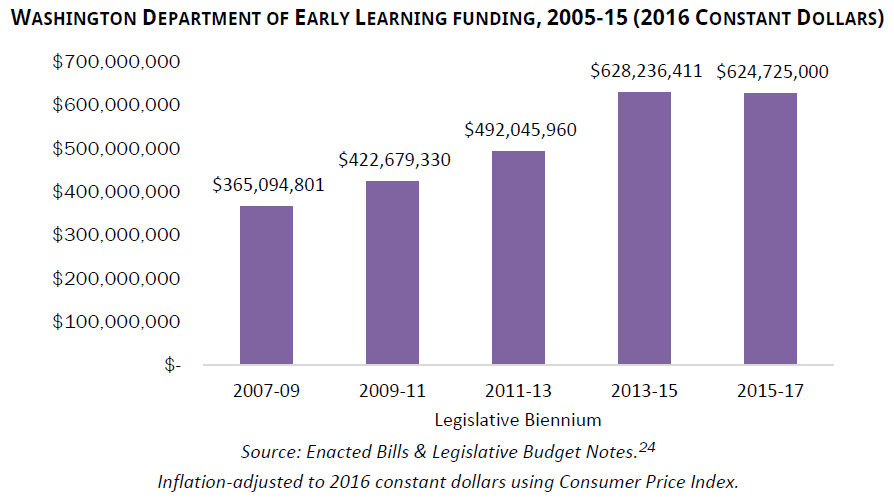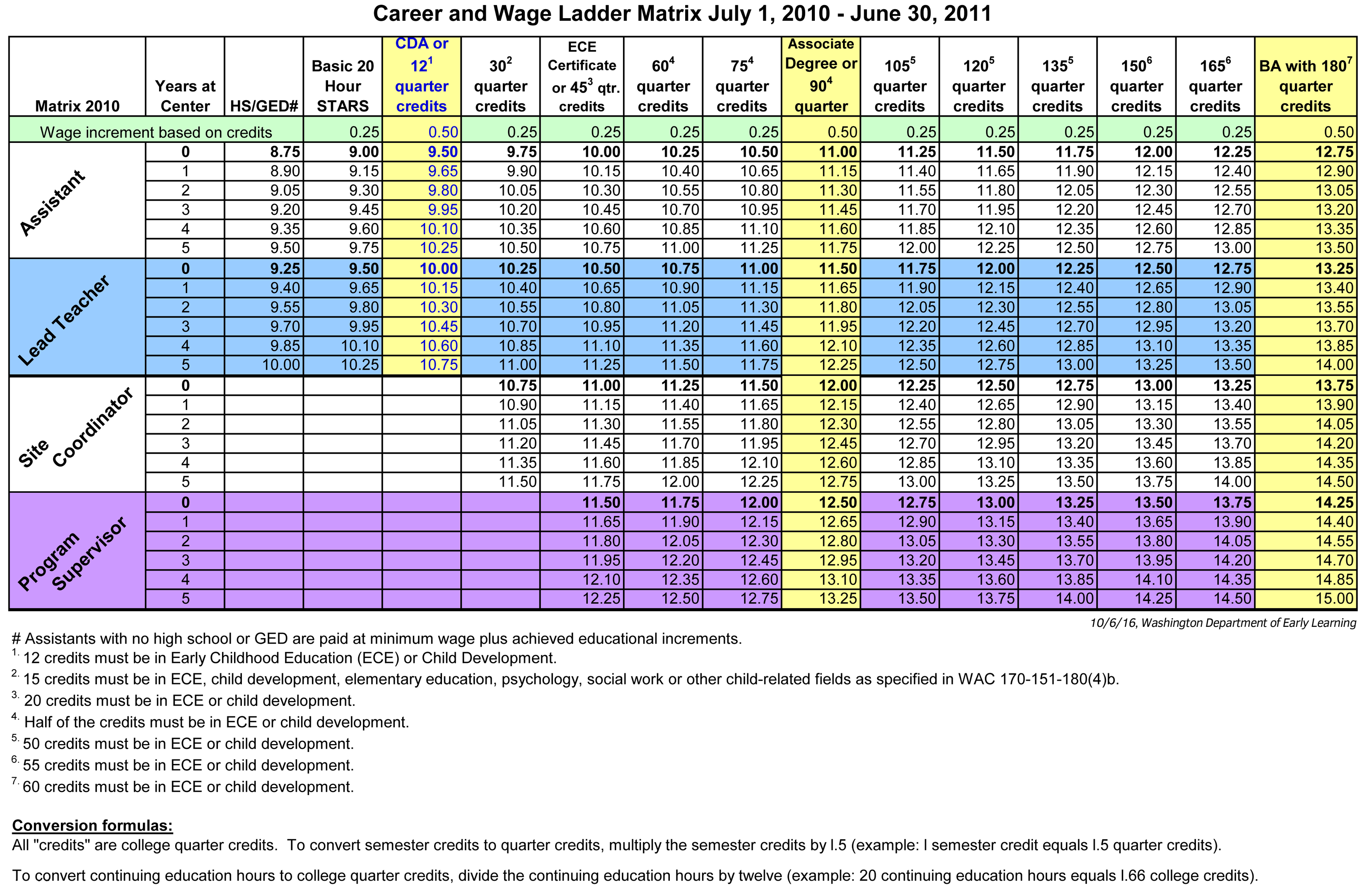For a PDF of this report, click here.
Washington has taken commendable steps toward building a high quality early childhood education system. Substantive public investment in early learning – primarily through the Early Childhood Education and Assistance Program (ECEAP) and Early Achievers Quality Rating and Improvement System (QRIS) – is expanding access, albeit to a limited degree, to affordable, quality child care.
However, a fundamental component is still missing from the state’s strategy: a well-compensated workforce. Despite the fact that pay incentives for additional education or years of experience promotes workforce retention and is directly linked to improved quality of care, wages for people working in child care remain near poverty level.
Integrating the state’s Child Care Career and Wage Ladder (already in law) with Early Achievers QRIS would tie compensation to quality – a tangible step toward improving early childhood education across Washington.
Steps forward: Investments in early learning via ECEAP and Early Achievers
Washington has made some substantive public investments in early learning that have successfully expanded access to affordable, quality child care – though the limited scope and implementation of these initiatives means they are far from a comprehensive solution.
The Early Childhood Education and Assistance Program (ECEAP) provides part-time to full-time care and education for eligible low-income 3- and 4-year olds across the state – but the number of eligible children far outnumbers available ECEAP slots. For the most part, ECEAP’s income ceilings limit eligibility to children in families at or below 110% of federal poverty level: $22,176 for a family of three and $26,730 for a family of four. Consequently, 80% of 3 and 4-year olds statewide do not qualify for assistance through the program. Even among those who do qualify, two-thirds are still unable to receive care.[1]
The Early Achievers QRIS (quality rating and improvement system) for child care providers is a work in progress. Designed around the nuances of child development and early learning theory, this 5-level QRIS system is intended to sustain the state through many years of quality improvement. Though its function is clear, the form of Early Achievers QRIS has proven difficult for child care providers to navigate, with their ability to advance through the levels limited by understaffing and high turnover rates. Just 3,596 licensed providers have enrolled, and less than 19% had moved beyond Level 2 in the program as of August 2016.[2]
Early Learning vs. Early Childhood Education vs. Child Care
Scientific research points to early life as a critical period: cognitive and socioemotional development is rapid and profound for the first two years, then continues throughout early childhood. State and federal public policy hasn’t caught up to this understanding yet, and often differentiates between the three terms. For example, many centers in Washington offer both “child care” and “early learning” programs for children of the same age – the difference between them being length of day, program curriculum, and teacher qualifications.
To get a strong start in life, children of all ages need to have their physical, social and emotional needs met and have lots of opportunities to learn. The infant and toddler years provide the foundation for a child’s development into a strong learner and social being. As such, the terms “early learning,” “early childhood education,” and “child care” go hand-in-hand – and are used interchangeably throughout this brief in reference to the valuable work of both caring for and educating children from birth through age five.
Low compensation, lack of workforce support hampering improvements
While Washington’s early learning policies (rightly) aim to support families and children, they don’t consider what kinds of support are necessary for people providing child care to actually carry out improvements. For example, built-in wage incentives for additional education or years of experience are directly linked to improved quality of care.[10] Yet such support is not included in the state’s strategy for improving early learning.
Financial security is recognized as an important factor in job performance and satisfaction in many sectors. Surveys show public esteem for early childhood teachers is high: roughly 90% of U.S. voters consider early childhood educators to be important members of the community, on par with nurses and firefighters.[11]
But with an annual income lower than that of pest control workers and tree trimmers,[12] child care workers make so little money that their families often qualify for the very ECEAP or Head Start programs in which they teach. Since 2010 the median wage for child care workers in Washington has increased by just 2%, while the median wage for pre-K teachers has actually decreased by 5%.[13] 39% of child care workers’ families participate in Medicaid, SNAP (Basic Food), and other public assistance programs.[14]
In every workplace, dignity, support, financial security and pay incentives enable professional excellence. Child care is no exception. As long as child care compensation remains near poverty level, efforts to improve quality will be less than fruitful. Absent a workforce-based mechanism through which quality can be achieved and sustained, legislating higher standards serves only to raise the bar for child care provider performance – not to help providers reach it.
Wage Ladder History
The Ladder originated as a pilot program through the executive action by Governor Gary Locke in 1999. The program was initially allocated $4 million, then $8 million in the 2001-03 biennium. Funding was discontinued after the 2002 recession, but the Wage Ladder’s success—demonstrated by a three-year external evaluation—prompted legislators to pass the Child Care Career and Wage Ladder into law in 2005 (HB 1636), and a supporting budget allocation the following year. Despite its effectiveness, the Ladder lost funding in 2011 amidst a series budget cuts related to the economic downturn and the end of federal stimulus funding.
Today the Wage Ladder remains a part of state law, though without fiscal backing – despite a $200 million+ overall funding increase for the Department of Early Learning since the 2009-2011 biennium, and a $75 million increase in funding for the Early Childhood Education and Assistance Program (ECEAP) over the same period.
The Wage Ladder: Building capacity and promoting professional excellence
As the state continues to move toward full economic recovery the need for caregivers and early educators will only grow; for ECEAP alone, Washington will need 266 more classrooms – and trained lead teachers and assistant teachers to staff them – by the year 2020.[20] ECEAP and Early Achievers alone cannot stimulate the growth in child care capacity that is desperately needed across the state. The Career and Wage Ladder can help retain already-committed professionals and attract new people to the field.
By providing state-subsidized wage increases for people working in child care who achieve additional formal education and/or remain in the child care workforce for an extended time, the Child Care Career and Wage Ladder can facilitate career development among existing teachers and improve worker retention. It would also attract new talent to the sector – and if structured well, could incentivize faster adoption of the Early Achievers program among providers while building additional child care capacity.
As noted in the Wage Ladder matrix (see Appendix), child care workers would receive incremental wage increases based on: years of work experience and increased job responsibility, high school diploma/GED attainment, and quarter credits obtained at a Washington community, technical, or four-year college.
These wage increases should be funded directly via a combination of state-financed revenue stream for compensation increments, and parallel center-based enhancements. Funding the Career and Wage Ladder does not require the passage of new legislation and could be leveraged as a “down payment” on child care compensation while a larger suite of sustainable, innovative solutions is developed.
The Ladder would best meet the needs of today’s child care worker and family needs by being fully integrated with Early Achievers, the state’s agreed-upon pathway towards quality improvement in the early learning system. Ideally, once enrolled in Early Achievers, any licensed child care facility, including family home child care providers, would be able to adopt the Career and Wage Ladder.[21] Under that scenario, $20 million of biennial budget funding for the Career and Wage Ladder ($10 million per fiscal year, or about a $.50 raise per teacher[22]) would cover over 10,000 child care workers and roughly 40% of child care centers across the state.[23]
Conclusion
The Early Start Act, ECEAP, and Early Achievers already point in the direction of excellence. Complementary workforce policies are essential for achieving it. Washington’s previous experience with the Career and Wage Ladder illustrates that investing in the child care workforce is a natural driver of high-quality early learning. Refunding the Ladder is a readily-available pathway toward meeting the state’s present and future need for high quality early childhood education. In so doing, legislators can ensure people working in child care are compensated more fairly, promote workforce development, and incentivize quality improvement in a way that reflects the social value of high-quality early childhood education.
Appendix
Notes
[1] Based on analysis of ECEAP legislation WAC 170-100-080 (amending WSR 10-20-059) and annual slots as reported by Washington Department of Early Learning.
[2] As of August 2016, based on EOI analysis of data from Child Care Aware of Washington, http://wa.childcareaware.org/about-us/data..
[3] Budgets, Washington State LEAP Committee, http://leap.leg.wa.gov/leap/budget/index_lbns.asp.
[4] Washington Department of Early Learning ECEAP Handout, Caseload Forecast Council, 15 June 2016, http://www.cfc.wa.gov/Handouts/DEL_ECEAP.pdf.
[5] Based on analysis of unpublished data from the Washington State Department of Early Learning.
[6] November 2015 State Population Forecast, Office of Financial Management, http://www.ofm.wa.gov/pop/stfc/.
[7] Washington Department of Early Learning ECEAP Handout, Caseload Forecast Council, 15 June 2016, http://www.cfc.wa.gov/Handouts/DEL_ECEAP.pdf.
[8] Licensed Child Care in Washington State: Market Rate Surveys 2006-2014, Washington Department of Early Learning, http://www.del.wa.gov/publications/research/default.aspx.
[9] November 2015 State Population Forecast, Office of Financial Management, http://www.ofm.wa.gov/pop/stfc/.
[10] Worthy Work, STILL Unlivable Wages: The Early Childhood Workforce 25 Years after the National Child Care Staffing Study, Marcy Whitebook, Deborah Phillips, and Carollee Howes, Center for the Study of Child Care Employment, Institute for Research on Labor and Employment, University of California, Berkeley, the State University of New Jersey, 2012, http://cscce.berkeley.edu/files/2014/ReportFINAL.pdf.
[11] Early Ed for President: Advancing the Power of the Profession, National Association for the Education of Young Children, https://www.cdcccc.org/uploads/pdf/1460143195_EEFP%20Presentation.Albany.pdf.
[12] Worthy Work, STILL Unlivable Wages: The Early Childhood Workforce 25 Years after the National Child Care Staffing Study, Marcy Whitebook, Deborah Phillips, and Carollee Howes, Center for the Study of Child Care Employment, Institute for Research on Labor and Employment, University of California, Berkeley, the State University of New Jersey, 2012, http://cscce.berkeley.edu/files/2014/ReportFINAL.pdf.
[13] Early Child Workforce Index 2016 – Washington, Center for the Study of Child Care Employment, http://cscce.berkeley.edu/files/2016/Index-2016-Washington.pdf.
[14] Worthy Work, STILL Unlivable Wages: The Early Childhood Workforce 25 Years after the National Child Care Staffing Study, Marcy Whitebook, Deborah Phillips, and Carollee Howes, Center for the Study of Child Care Employment, Institute for Research on Labor and Employment, University of California, Berkeley, the State University of New Jersey, 2012, http://cscce.berkeley.edu/files/2014/ReportFINAL.pdf.
[15] Licensed Child Care in Washington State: Market Rate Surveys 2006-2014, Washington Department of Early Learning, http://www.del.wa.gov/publications/research/default.aspx.
[16] Licensed Child Care in Washington State: 2014 Market Rate Survey, Department of Early Learning, http://www.del.wa.gov/publications/research/default.aspx.
[17] Washington State Department of Early Learning ECEAP Handout, Caseload Forecast Council, 15 June 2016, http://www.cfc.wa.gov/Handouts/DEL_ECEAP.pdf.
[18] Licensed Child Care in Washington State: 2014 Market Rate Survey, Department of Early Learning, http://www.del.wa.gov/publications/research/default.aspx.
[19] Based on analysis of unpublished data from the Washington State Department of Early Learning.
[20] Washington Makes Gains in Pre-K Funding and Enrollment, Department of Early Learning, 12 May 2016, https://www.del.wa.gov/node/28.
[21] Prior to 2012, family home child care providers were not included in the Career and Wage Ladder. The law, however, is quite flexible when it comes to minimum standards of eligibility, making the inclusion of licensed family providers an issue easily addressed through budget proviso language.
[22] Projection based on full day, year-round child care, or a 2,080-hour work year for the average teacher.
[23] Licensed Child Care in Washington State: 2014 Market Rate Survey, Washington Department of Early Learning, http://www.del.wa.gov/publications/research/default.asp.
[24] Budgets, Washington State LEAP Committee, http://leap.leg.wa.gov/leap/budget/index_lbns.asp.
More To Read
September 6, 2024
Tax Loopholes for Big Tech Are Costing Washington Families
Subsidies for big corporations in our tax code come at a cost for college students and their families
July 18, 2024
Protect Washington’s Kids by Protecting the Capital Gains Tax
Vote NO on I-2109 to keep funding for public education and childcare
July 8, 2024
The Washington Future Fund: Baby Bonds as Wealth Building
Inspiring academic and economic opportunities for Washington's future

